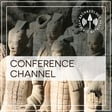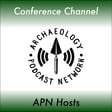Become a Creator today!Start creating today - Share your story with the world!
Start for free
00:00:00
00:00:01

066 - EAA2019 - Dr. Chester Liwosz
At the EAA2019 conference in Bern, Tristan of the APN had a chance to sit down and talk to Dr. Chester Liwosz of the Mesa Prieta Petroglyph Project based in New Mexico.
The Mesa Prieta Petroglyph Project (MPPP), a tax-exempt 501 (c)(3) non-profit organization founded in 1999, seeks to preserve petroglyphs on Mesa Prieta through education of the local community and others, and recording what may be well over 100,000 rock images on the mesa.
Recommended
Transcript
Introduction and Setting at EAA 2019
00:00:00
Speaker
You're listening to the Archaeology Podcast Network. Hi, it's Tristan here at the EAA 2019. We're kind of sitting here in the Uni-S building that's over the road from the Hauptgeboide. And it's just gone past
Introducing Chester Levash and Rock Art Basics
00:00:17
Speaker
lunch. We're chilling out and taking a little time between the sessions to talk about rock art today. So I'm sitting here with, is it Dr. Chester?
00:00:28
Speaker
All right, so I'm Chester Levash. I work for the Mesoprieta Petroglyph Project in northern New Mexico. I'm the project archaeologist there. So, Petroglyphs Rock Art, there's lots of different names for it. How would you broadly describe it to someone who's never ever seen it before or heard of it before?
00:00:52
Speaker
So, there's two basic types of rock art. There's petroglyphs, which are carved images, and then there's pictographs, which are painted images. And
Preservation Challenges and Technological Aids
00:01:03
Speaker
then you get a lot of images that have, they're both a pictograph and a petroglyph. And what's the kind of preservation that goes on with this? Because obviously, a stone can be worn away, depends on the type of stone and stuff. What condition do we usually find these petrographs, which are the ones that are carved?
00:01:22
Speaker
So, you know, often exposed to the weather, there's not much extra preservation that needs to be done. It takes minimally centuries, sometimes millennia, for them to start developing or redeveloping a patina once the patina on the outside of the stone has been busted through.
00:01:43
Speaker
Pictographs are a little bit more sensitive because they tend to melt and drip. And so
Classification and Interpretation of Rock Art
00:01:51
Speaker
those are often mostly only preserved in areas with overhangs or some kind of protection.
00:02:00
Speaker
One of the steps we can take, even if, say with pictographs, if we can't intervene and stop that weathering process, is to use software to recover some of the design that's still latent, if not visible to the naked eye. But then all of these are also susceptible to erosion of a different kind. So for examples that might be on boulders, the landscape
00:02:29
Speaker
Underneath them could a road out and we've had examples of boulders just falling off the slope entirely into the road.
00:02:39
Speaker
It's pretty amazing. Could you kind of like give an overview of the kind of shapes and things that we can expect to see on these rock arts? So there's I'm seeing in front of me human figures. I think there's animals. I mean, what? I mean, obviously, every drawing is unique, I guess, but there must be you have a way of categorizing stuff, right?
00:03:04
Speaker
Certainly. In the broadest sense, we tend to distinguish between abstract geometric forms. Often the more complex ones fall into what David Lewis Williams called entoptic images, images which seem to be derived from within the human nervous system. This contrasts with what has formerly been called representational images, what we're now trying to move towards calling figurative images.
00:03:34
Speaker
things that look like recognizable things. This doesn't mean that they necessarily represent the thing that they look like, but that there's a familiar form to them. Then
Dating Rock Art Across Regions
00:03:48
Speaker
regionally of course we have
00:03:50
Speaker
We have different style classifications that, as I said, vary regionally. And these tend to be conventions that are established, you know, either in the scholarly literature or by avocational recorders, basically whoever gets the most data first.
00:04:08
Speaker
And one of the complications is when you run into bordering regions, that these classification systems that break things down into details of what kind of motif this is, sometimes they fall short on some of the variations that you find within that. Or the rock art in neighboring regions might be
00:04:31
Speaker
fairly similar, but simply by convention of recording, the classification systems are really different. I'm just wondering then, obviously that is an issue that kind of has to be then mediated out. What kind of time, how old are some of these drawings? Like what's the oldest, what's the youngest?
00:04:53
Speaker
Well, so I've got an example here of the Rio Grande style from what we call the Pueblo in classic period. Some folks might also recognize this as Pueblo IV.
00:05:10
Speaker
These would be after 1350 AD, fairly recent in petroglyph standards, versus if we were to look at something like the COSO range,
00:05:25
Speaker
then the numerous images there are mostly believed to date to more than 2,200 years ago and some of the earliest stuff in that region, such as an example dated by examining that patina that's developed on the surface called a desert varnish. In Death Valley, at least one element has dated to more than 14,000 years old.
00:05:54
Speaker
So
Indigenous Collaboration and Archaeological Trust Issues
00:05:55
Speaker
they may go back to, at least in North America, some of the earliest peopling of the Americas. And obviously with that sense of deep time, it means that dealing with this obviously means that you are dealing with indigenous peoples, indigenous communities. How does that kind of work on a kind of level? How do you consult and how do you work with indigenous communities?
00:06:24
Speaker
Good question. If anyone has some answers to that, I'd like to know. That's not what calls attention, is it, do you think?
00:06:34
Speaker
It has been and so with some groups we have to be patient and establish a relationship in part because some of the archaeology including around the rock art in the Great Basin has been used to
00:06:55
Speaker
disconnect indigenous peoples from their cultural heritage with real political consequences. Tribes have lost land claims because of archaeologists not getting the connections between the anthropological record and what they're saying in the rock art, or sometimes not understanding the metaphorical ways in which tribes will describe these things.
00:07:23
Speaker
So there's been a lot of distrust built up over the last few generations, but I think most of the folks in the current and up-and-coming generation of archaeologists were much more oriented towards that community engagement to begin with, and so we're trying to rebuild those bridges.
00:07:50
Speaker
In other areas, the history hasn't been quite so contentious. So if we were to look at, say, the Pueblo and Southwest, there's never been any doubt that, you know, at least a certain style of image there was created by ancestors of Puebloan peoples living there today.
00:08:11
Speaker
And so in those cases, groups might be more open to discussing things.
Outreach Strategies with Indigenous Communities
00:08:17
Speaker
Now, of course, this is also all assuming that there is still a cultural memory of these things, which the sort of processes of contact and colonization have often eradicated a lot of the cultural memory in the last, you know, two to 300 years.
00:08:37
Speaker
I mean, it's obviously a difficult thing that most archaeologists who work in America have to deal with. It's definitely something that we hope can actually be developed on and grown and it's something that gets better. Do you guys do a lot of outreach? Is there any ways or something that people can follow online, anything like that about this?
00:09:01
Speaker
Personally, not really. I think a lot of it develops on a case-by-case basis. So there's a lot of face-to-face introductions, if you can manage that. But otherwise, often, say if you're working for a state or federal government agency or working through those,
00:09:26
Speaker
Then there's a legal requirement to go, to consult government to government, which requires a federal employee to set up a meeting with a tribal government official. This process can, you know, sometimes take years just to get that first meeting. But
Conclusion and Podcast Network Information
00:09:45
Speaker
yeah, the process is very highly variable.
00:09:50
Speaker
And it also tends to begin with sorts of introductions and meeting faces and just trying to build mutual trust. That's great. Thank you. This has been a presentation of the Archaeology Podcast Network. Visit us on the web for show notes and other podcasts at www.archpodnet.com. Contact us at chrisatarchaeologypodcastnetwork.com.

